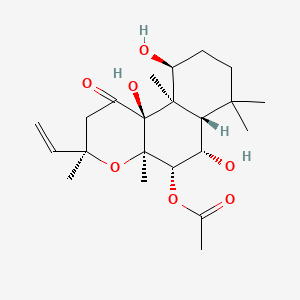| MeSH term | MeSH ID | Detail |
|---|---|---|
| Melanoma | D008545 | 69 associated lipids |
| Growth Disorders | D006130 | 5 associated lipids |
| Weight Gain | D015430 | 101 associated lipids |
| Cardiovascular Diseases | D002318 | 24 associated lipids |
| Glioma | D005910 | 112 associated lipids |
| Cell Transformation, Neoplastic | D002471 | 126 associated lipids |
| Liver Neoplasms, Experimental | D008114 | 46 associated lipids |
| Thrombosis | D013927 | 49 associated lipids |
| Hypertension, Pulmonary | D006976 | 32 associated lipids |
| Bradycardia | D001919 | 13 associated lipids |
forskolin
Forskolin is a lipid of Prenol Lipids (PR) class. Forskolin is associated with abnormalities such as Cholestasis, Vocal cord dysfunction familial, Hypothyroidism, Renal tubular disorder and Disintegration (morphologic abnormality). The involved functions are known as Cell Proliferation, Anabolism, mRNA Expression, Agent and Signal. Forskolin often locates in Extracellular, Body tissue, Skin, Tissue membrane and Membrane. The associated genes with forskolin are P4HTM gene, SLC33A1 gene, NR1I2 gene, Genes, Reporter and CYP3A gene. The related lipids are Steroids, steroid sulfate, Fatty Acids, LYSO-PC and Lipopolysaccharides.
Cross Reference
Introduction
To understand associated biological information of forskolin, we collected biological information of abnormalities, associated pathways, cellular/molecular locations, biological functions, related genes/proteins, lipids and common seen animal/experimental models with organized paragraphs from literatures.
What diseases are associated with forskolin?
forskolin is suspected in Cyst, Kozlowski Celermajer Tink syndrome, Vocal cord dysfunction familial, Alzheimer's Disease, Cholestasis, Renal tubular disorder and other diseases in descending order of the highest number of associated sentences.
Related references are mostly published in these journals:
- J. Biol. Chem. (4)
- Am. J. Physiol. Regul. Integr. Comp. Physiol. (1)
- Am. J. Physiol. Renal Physiol. (1)
- Others (9)
| Disease | Cross reference | Weighted score | Related literature |
|---|
Possible diseases from mapped MeSH terms on references
We collected disease MeSH terms mapped to the references associated with forskolin
PubChem Associated disorders and diseases
What pathways are associated with forskolin
Lipid pathways are not clear in current pathway databases. We organized associated pathways with forskolin through full-text articles, including metabolic pathways or pathways of biological mechanisms.
Related references are published most in these journals:
| Pathway name | Related literatures |
|---|
PubChem Biomolecular Interactions and Pathways
Link to PubChem Biomolecular Interactions and PathwaysWhat cellular locations are associated with forskolin?
Visualization in cellular structure
Associated locations are in red color. Not associated locations are in black.
Related references are published most in these journals:
| Location | Cross reference | Weighted score | Related literatures |
|---|
What functions are associated with forskolin?
Related references are published most in these journals:
| Function | Cross reference | Weighted score | Related literatures |
|---|
What lipids are associated with forskolin?
Related references are published most in these journals:
| Lipid concept | Cross reference | Weighted score | Related literatures |
|---|
What genes are associated with forskolin?
Related references are published most in these journals:
| Gene | Cross reference | Weighted score | Related literatures |
|---|
What common seen animal models are associated with forskolin?
There are no associated biomedical information in the current reference collection.
NCBI Entrez Crosslinks
All references with forskolin
Download all related citations| Authors | Title | Published | Journal | PubMed Link |
|---|---|---|---|---|
| Savard C et al. | Prevention of deoxynivalenol- and zearalenone-associated oxidative stress does not restore MA-10 Leydig cell functions. | 2016 | Toxicology | pmid:26783879 |
| Malty RH et al. | Long-term exposure to PGE2 causes homologous desensitization of receptor-mediated activation of protein kinase A. | 2016 | J Neuroinflammation | pmid:27400965 |
| Koyama H et al. | Comprehensive Profiling of GPCR Expression in Ghrelin-Producing Cells. | 2016 | Endocrinology | pmid:26671185 |
| Ignea C et al. | Production of the forskolin precursor 11β-hydroxy-manoyl oxide in yeast using surrogate enzymatic activities. | 2016 | Microb. Cell Fact. | pmid:26920948 |
| Pinne M et al. | Transactivation Assays to Assess Canine and Rodent Pregnane X Receptor (PXR) and Constitutive Androstane Receptor (CAR) Activation. | 2016 | PLoS ONE | pmid:27732639 |
| Li L et al. | Differential effects of lysophosphatidylcholine and ACh on muscarinic K(+),non-selective cation and Ca(2+) currents in guinea-pig atrial cells. | 2016 | Fukushima J Med Sci | pmid:26911304 |
| Jones AR et al. | Extracellular Redox Regulation of Intracellular Reactive Oxygen Generation, Mitochondrial Function and Lipid Turnover in Cultured Human Adipocytes. | 2016 | PLoS ONE | pmid:27741233 |
| Na YR et al. | Endogenous prostaglandin E2 potentiates anti-inflammatory phenotype of macrophage through the CREB-C/EBP-β cascade. | 2015 | Eur. J. Immunol. | pmid:26118414 |
| Zhang Y et al. | Resveratrol improves hepatic steatosis by inducing autophagy through the cAMP signaling pathway. | 2015 | Mol Nutr Food Res | pmid:25943029 |
| Woodworth BA | Resveratrol ameliorates abnormalities of fluid and electrolyte secretion in a hypoxia-Induced model of acquired CFTR deficiency. | 2015 | Laryngoscope | pmid:25946147 |
